Mushrooms
Media

Species Types
Scientific Name
Boletus frostii
Description
Frost’s bolete has a blood red cap with red pores and a red, webbed stalk; all parts bruise blue. It grows scattered on the ground in oak woods.
Media
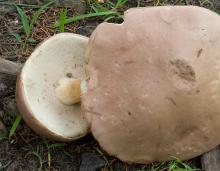
Species Types
Scientific Name
Boletus pallidus
Description
The pallid bolete has a pale cream to buff cap and stalk and pale cream-yellow pores. It grows singly or in groups of up to several, on the ground in oak woods.
Media
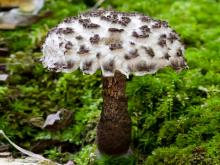
Species Types
Scientific Name
Strobilomyces floccopus
Description
The old man of the woods has a grayish black, shaggy cap with grayish pores and a grayish black, shaggy stalk. It usually grows singly, on the ground in mixed hardwood forests.
Media
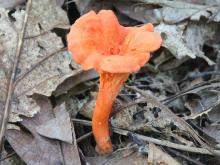
Species Types
Scientific Name
Cantharellus cinnabarinus
Description
The cinnabar chanterelle is a small, reddish orange, vase-shaped mushroom with forked ridges on the underside that descend the stalk. It grows in the soil.
Media
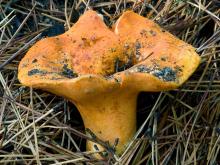
Species Types
Scientific Name
Hypomyces lactifluorum
Description
In a lobster mushroom, the cap, gills, and stalk of a host mushroom are covered by a finely bumpy, vivid orange to orange-red layer of mold. The gills of the host mushroom can be entirely obscured by the parasite.
Media

Species Types
Scientific Name
Cantharellus lateritius
Description
The smooth chanterelle has a bright orange to yellow cap, wavy margins, and is smooth on the underside. It grows singly or in large groups in the soil.
Media

Species Types
Scientific Name
Phallus ravenelii
Description
Ravenel's stinkhorn is a long, whitish column with a greenish, smelly slime covering the top, and a whitish or pinkish cup around the base. It grows on wood debris, mulch, rotted stumps, and sawdust, and in deciduous woods.
Media
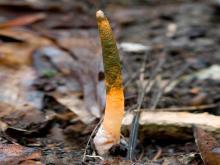
Species Types
Scientific Name
Mutinus elegans
Description
The elegant stinkhorn is a long, tapered, pinkish orange column with a greenish brown, smelly slime covering the top and a white cup around the base. It grows on leafy debris, mulch piles, and rotting wood.
Media
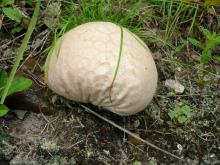
Species Types
Scientific Name
Calvatia gigantea (Langermannia gigantea)
Description
The giant puffball is a huge, white, smooth ball with a completely white interior that becomes yellowish green with age. It grows in open pastures, woods, and lawns.
Media
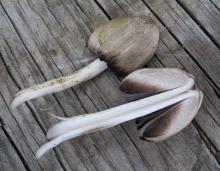
Species Types
Scientific Name
Coprinopsis atramentaria (formerly Coprinus atramentarius)
Description
The alcohol inky has a gray-brown, bell-shaped, radially lined cap and inky gills. It grows in clusters on the ground, usually near rotting or buried wood.
See Also



Media

Species Types
Scientific Name
Monotropa hypopitys
Description
Pinesap is a plant that puts the "wild" in wildflower! It lacks chlorophyll, so its roots connect to fungi underground and absorb nutrients from the fungi.
Media

Species Types
Scientific Name
Cladophora, Pithophora, and Spirogyra spp., and others
Description
Filamentous green algae forms green, cottony masses that are free-floating or attached to rocks, debris, or other plants.
Media

Species Types
Scientific Name
Monotropa uniflora
Description
Indian pipe lacks chlorophyll, so it is white, not green. Below ground, its roots join with fungi that connect to tree roots. This plant, then, takes nourishment indirectly from the trees.
About Mushrooms in Missouri
Mushrooms are a lot like plants, but they lack chlorophyll and have to take nutrients from other materials. Mushrooms are neither plants nor animals. They are in a different kingdom — the fungi. Fungi include the familiar mushroom-forming species, plus the yeasts, molds, smuts, and rusts.
Always be cautious when eating edible mushrooms. Be absolutely sure of the ID, and only eat a small amount the first time you try it to avoid a reaction..





















